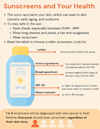Sun Safety and Environmental Health
Sun Safety and Environmental Health
There are many myths and misconceptions around sun safety and sunscreens, including wearing sunscreen is unsafe. Misconceptions about sunscreen safety may lead people to believe that homemade sunscreen is just as effective and may be safer than store-bought sunscreen, which is not true. To help combat sunscreen misconceptions, we developed a sun safety infographic, fact sheet, and resource guide.
Types of Sunscreens
There are two types of sunscreens: mineral-based sunscreen and chemical-based sunscreen.
Mineral-based sunscreens protect your skin by reflecting the sun’s rays away from the skin. To know if a sunscreen is a mineral-based sunscreen, check the ingredients. The active ingredients will be zinc oxide and/or titanium dioxide, both of which are considered safe and effective by the FDA. Mineral-based sunscreens are recommended for sensitive skin, and they provide immediate protection against the sun.
Chemical-based sunscreens protect your skin by absorbing the sun’s rays. The active ingredients of chemical-based sunscreens include avobenzone, oxybenzone, homosalate, and octinoxate. Chemical-based sunscreens are easy to apply and appear transparent on the skin. Because chemical-based sunscreens absorb into the skin, these sunscreens may cause allergic reactions or other health effects.
No matter which type of sunscreens you use, it is important to always apply sunscreen when spending time outside!
What are we doing
To provide evidence-based information around sunscreen and sun safety, we developed a sun safety infographic and fact sheet addressing both the health risks of sun exposure and concerns about certain chemical sun screen ingredients.
 A Sun Safety Infographic
A Sun Safety Infographic Fact Sheet
Fact Sheet